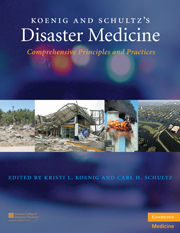Book contents
- Frontmatter
- Contents
- List of Contributors
- Contributor Biographies
- Foreword
- Preface
- Acknowledgments
- PART I CONCEPTUAL FRAMEWORK AND STRATEGIC OVERVIEW
- PART II OPERATIONAL ISSUES
- 9 Public Health and Emergency Management Systems
- 10 Legislative Authorities and Regulatory Issues
- 11 Syndromic Surveillance
- 12 Triage
- 13 Personal Protective Equipment
- 14 Decontamination
- 15 Quarantine
- 16 Mass Dispensing of Antibiotics and Vaccines
- 17 Management of Mass Gatherings
- 18 Transportation Disasters
- 19 Emergency Medical Services Scene Management
- 20 Healthcare Facility Disaster Management
- 21 Mass Fatality Management
- 22 Crisis and Emergency Risk Communication
- 23 Telemedicine and Telehealth Role in Public Health Emergencies
- 24 Complex Public Health Emergencies
- 25 Patient Identification and Tracking
- PART III CLINICAL MANAGEMENT
- Index
- Plate section
- References
21 - Mass Fatality Management
from PART II - OPERATIONAL ISSUES
Published online by Cambridge University Press: 05 August 2011
- Frontmatter
- Contents
- List of Contributors
- Contributor Biographies
- Foreword
- Preface
- Acknowledgments
- PART I CONCEPTUAL FRAMEWORK AND STRATEGIC OVERVIEW
- PART II OPERATIONAL ISSUES
- 9 Public Health and Emergency Management Systems
- 10 Legislative Authorities and Regulatory Issues
- 11 Syndromic Surveillance
- 12 Triage
- 13 Personal Protective Equipment
- 14 Decontamination
- 15 Quarantine
- 16 Mass Dispensing of Antibiotics and Vaccines
- 17 Management of Mass Gatherings
- 18 Transportation Disasters
- 19 Emergency Medical Services Scene Management
- 20 Healthcare Facility Disaster Management
- 21 Mass Fatality Management
- 22 Crisis and Emergency Risk Communication
- 23 Telemedicine and Telehealth Role in Public Health Emergencies
- 24 Complex Public Health Emergencies
- 25 Patient Identification and Tracking
- PART III CLINICAL MANAGEMENT
- Index
- Plate section
- References
Summary
OVERVIEW
For a civilization to deserve that name, all of life must be valued, including the absent life of the dead. Mate Reyes
INTRODUCTION
Although many methods exist to measure the impact of a disaster, the number of dead speaks the loudest. Caring for the sick, injured, and displaced is understandably the most important work of disaster responders. For the public, media, government, and society, however, the number of disaster fatalities reflects the true magnitude of the tragedy. Acknowledging the effort of mass fatality managers is largely focused on the dead; the work is actually done for the living.
The disaster dead must be located, recovered, transported, stored, examined, documented, tested, identified, and returned to families for final disposition. Each step requires specialists in forensic science and funeral services. The processing of the dead follows legal requirements dictated by the disaster and by the jurisdiction in which the event occurred. For example, scenes of terrorist bombings must be managed and documented at a level that would not be required for every type of disaster because terrorism is considered to be a criminal activity.
The physical processing of the dead encompasses logistical and scientific considerations, such as location and recovery of remains, forensic identification efforts, handling of the dead, and the final disposition of remains. Information about these processes must be provided to family members, the media, and politicians.
Keywords
- Type
- Chapter
- Information
- Koenig and Schultz's Disaster MedicineComprehensive Principles and Practices, pp. 312 - 325Publisher: Cambridge University PressPrint publication year: 2009



